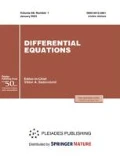Abstract
We prove a comparison theorem for the solutions of Riccati matrix equations in which the diagonal entries of the matrix multiplying the linear term are perturbed by a bounded function. This theorem is used to study optimal trajectories in a pollution control problem stated in the form of a linear regulator over an infinite time horizon with a discount function of the general form.
Similar content being viewed by others
References
Reid, W.T., Riccati Differential Equations, New York, 1972.
Royden, H.L., Comparison Theorems for the Matrix Riccati Equation, Commun. Pure Appl. Math., 1988, vol. 41, no. 5, pp. 739–746.
Jones, R.A., Comparison Theorems for Matrix Riccati Equations, SIAM J. Appl. Math., 1975, vol. 29, no. 1, pp. 77–90.
Juang, J. and Lee, M.T., Comparison Theorems for the Matrix Riccati Equation, Linear Algebra Appl., 1994, vol. 196, pp. 183–191.
Abou-Kandil, H., Freiling, G., Ionescu, V., and Jank, G., Matrix Riccati Equations in Control and Systems Theory, Basel, 2003.
Ichikawa, A. and Katayama, H., Linear Time Varying Systems and Sampled-Data Systems, London, 2001.
Kwakernaak, H. and Sivan, R., Linear Optimal Control Systems, New York–London–Sydney: Wiley–Interscience, 1972. Translated under the title Lineinye optimal’nye sistemy upravleniya, Moscow: Mir, 1977.
Palamarchuk, E.S., Risk Estimation in Linear Economic Systems for Negative Time Preferences, Ekon. i Mat. Metody, 2013, vol. 49, no. 3, pp. 99–116.
Komornik, J., Asymptotic Behavior of Solutions of Nonautonomeous Riccati Equations, Proc. of the 9th IFIP Conference on Optimization Techniques, Berlin, 1980, pp. 318–323.
Mueller, M. and Cantoni, M., Normalized Coprime Representations for Time-Varying Linear Systems, Proc. of the 49th IEEE Conference on Decision and Control, New York, 2010, pp. 7718–7723.
De Spinadel, V., On Optimal Control, in Linear Algebra and Its Role in Systems Theory, Providence, 1985, pp. 111–120.
The Formulation of Time Preferences in a Multidisciplinary Perspective, Kirsch, G., Nijkamp, P., and Zimmermann, K., Eds., Aldershot, 1988.
Loewenstein, G. and Prelec, D., Anomalies in Intertemporal Choice: Evidence and an Interpretation, Quart. J. Econ., 1992, vol. 107, no. 2, pp. 573–597.
Choi, C.H., A Survey of Numerical Methods for Solving Matrix Riccati Differential Equations, Proc. of the IEEE Southeastcon’90, New York, 1990, pp. 696–700.
Author information
Authors and Affiliations
Corresponding author
Additional information
Original Russian Text © E.S. Palamarchuk, 2016, published in Differentsial’nye Uravneniya, 2016, Vol. 52, No. 8, pp. 1020–1025.
Rights and permissions
About this article
Cite this article
Palamarchuk, E.S. Comparison theorem for a class of Riccati differential equations and its application. Diff Equat 52, 981–986 (2016). https://doi.org/10.1134/S0012266116080036
Received:
Published:
Issue Date:
DOI: https://doi.org/10.1134/S0012266116080036



